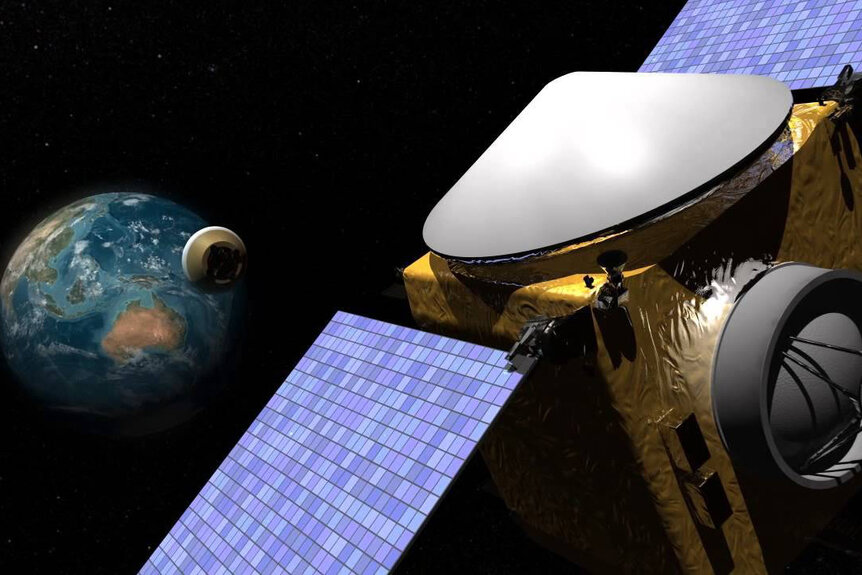Create a free profile to get unlimited access to exclusive videos, sweepstakes, and more!
NASA snatched a sample of an asteroid, now they’re returning it to Earth
In an ideal world, we touch asteroids but they don't touch us.

Humanity has a tricky relationship with asteroids. Every once in a while, they come out of nowhere to smack us around a little, and we know that at least one of them tried to wipe out life on our planet entirely. Still, asteroids, the leftover two-by-fours from the solar system’s construction, are an endlessly fascinating source of scientific discovery.
They are, from a certain point of view, the cosmic equivalent of wild tigers. Potentially fatal, but not so dangerous as long as you know where they are and keep your eye on them. It’s that unique position that makes asteroids the subject both of disaster movies like Asteroid vs. Earth (streaming now on Peacock!) and of incredible scientific missions more than a decade in the making.
NASA’s Origins, Spectral Interpretation, Resource Identification, Security-Regolith Explorer (OSIRIS-REx) is a sample retrieval craft designed to study and steal pieces of asteroids. The craft launched September 8, 2016, from Cape Canaveral, beginning a years-long journey to the asteroid Bennu. When it lands later this year, it will be NASA’s first asteroid sample return mission and the third for the world, following visits to 25143 Itokawa and 162173 Ryugu by the Japan Aerospace Exploration Agency (JAXA).
RELATED: BOOP! NASA spacecraft OSIRIS-REx pokes an asteroid and collects the debris
OSIRIS-REx arrived at Bennu more than two years after launch and successfully entered into orbit around the asteroid at an altitude of about 19 miles. From December 2018 until October 2020, the craft remained in orbit, studying Bennu from a short distance. Then, on October 20, 2020, OSIRIR-REx made its move. The spacecraft matched Bennu’s rotation speed before beginning its descent to the asteroid’s surface. It stretched its sample retrieval arm toward the asteroid and angled the solar panels and high-gain antenna away. Then it dipped its robotic toe into the deep space sands of a distant asteroid.
It had to dip its toe because landing would have been disastrous. We think of asteroids as hulking, solid rocks drifting through space. Some of them are like that, but others are loosely affiliated collections of rock, dust, ice, and gas, held together only through the gentle influence of gravity. Imagine throwing a bunch of rocks and pebbles onto a trampoline and watching them all huddle together in the middle, under the collective influence of their weight, and you’re pretty close to the truth. Landing on Bennu would have been like jumping on the trampoline. Your rock pile is going to get all messed up and you’re going to get hurt.
Instead, scientists equipped the craft with the Touch-And-Go Sample Acquisition Mechanism (TAGSAM). In short, it’s a piece of equipment designed to grab a sample of something and then get far away, as quickly as possible. When the arm made contact with Bennu, it released a burst of nitrogen which kicked up rocks and dust, some of which were trapped in a collection chamber. Then it reversed course and got out of there posthaste, and it’s a good thing too. Examination of Bennu after collection revealed that the surface was even less stable than we had guessed.
RELATED: OSIRIS-REx is now going to go asteroid hopping to the space rock that once threatened Earth
The act of the craft slipping down to scoop up a piece of the asteroid scoured a 26-foot hole in the surface of the asteroid, and the probe itself sunk an estimated 30 inches (70 centimeters) beneath the surface. That might be good news for scientists hoping to study the sample, because it means the craft may have scooped up pristine material from beneath the surface, unaltered by interactions with solar winds or cosmic rays.
With the sample in hand, OSIRIS-REx spent another six months studying the asteroid from a safe distance before pointing itself back toward Earth. On May 10, 2023, it pushed the pedal to the floor and accelerated to about 600 miles per hour (1,000 kph). On its present course, the craft is expected to rendezvous with Earth in September of this year. When it gets close, it will eject its sample container, sending it to its landing position in Utah’s West Desert.
The craft, having completed its primary mission, will then go on to an extended mission to the asteroid Apophis. You might remember it from a couple of years ago when there was a slim chance it might strike Earth. That didn’t happen of course, and Apophis is on its way back for another near-Earth flyby in 2029. That’s when the craft, then-dubbed OSIRIS-APEX (the latter portion standing for APophis EXplorer), will hitch a ride around its second asteroid.
In the meantime, scientists will be hard at work investigating the sample returned from Bennu. It’s estimated that the sample container holds about 9 ounces of material (250 grams) give or take and will land within an ellipse 37 miles by 9 miles (59 by 15 kilometers). Once the sample parachutes into the desert, scientists will race to retrieve it and take it to a temporary clean room. Once there, the team will remove the heat shield and exterior shell to get to the canister inside. Ultimately, the sample is destined for a newly built lab, custom made for studying this material. Over the next six months, teams in Utah and Colorado are running drills, practicing the retrieval and transport procedure, to ensure that our hard-earned canister of space dirt gets to its lab safely.
Most of the time you don’t want any part of an asteroid to hit your planet. Sometimes you want it to land just right. Catch Asteroid vs. Earth, streaming now on Peacock!



























